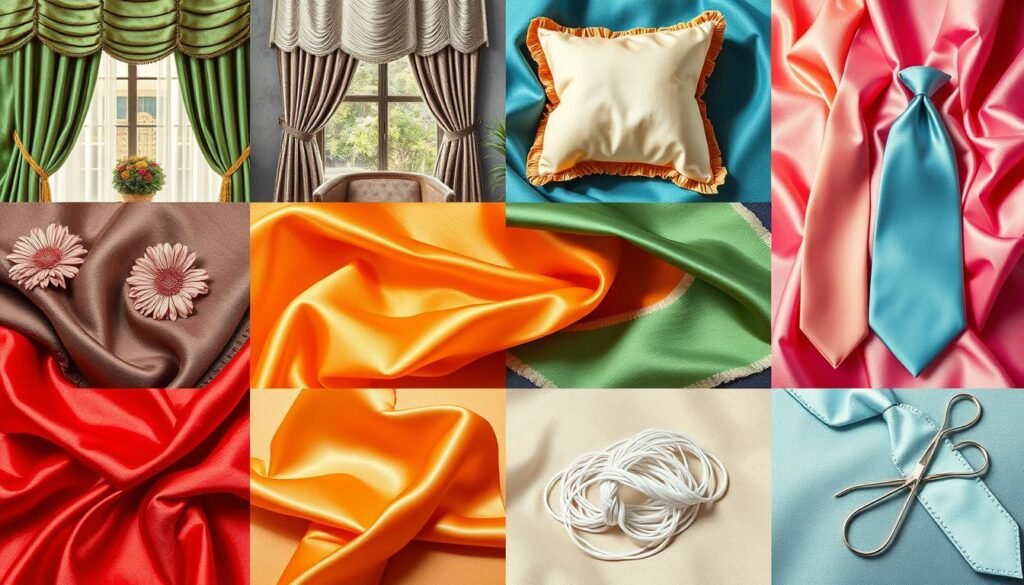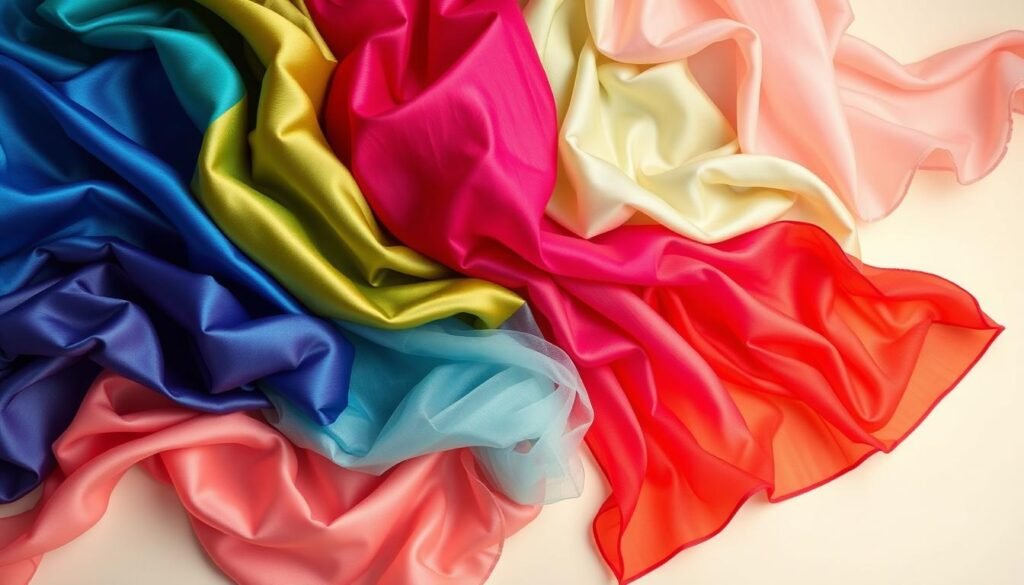Ever wondered about the origins and unique features of silk fabric? Silk is a natural fiber that has amazed people for thousands of years. It’s known for being very soft, long-lasting, and having a beautiful way of hanging. But what makes silk special, and how does it stand out from other fabrics? Let’s explore this guide to learn more about this fascinating textile1.
Silk started in ancient China around 6000 BC1. The Chinese kept its production secrets for a long time, controlling the global market. Now, silk is made in many places, but it’s still a favorite and highly desired fabric1.
Key Takeaways
- Silk is a natural textile fiber made by certain insect larvae, like the Bombyx mori silkworm.
- Silk is famous for its shiny look, smooth feel, and amazing way of hanging.
- The making of silk began in ancient China, way back in the Neolithic period.
- Silk is used to make many clothes and is loved for its softness, lasting quality, and flexibility.
- Silk is also used in home decor, industrial products, and for weddings.
The Origins and History of Silk Fabric
Silk started in ancient China, where Empress Leizu found it in 2696 BC2. Now, after 4700 years, silk making is still going strong2. The first silk fabrics were made around 3630 BC in China’s Neolithic period2.
Silk Production in Ancient China
Silk was only made in East Asia until the Silk Road opened during the Western Han Dynasty3. China kept silk a secret for about a thousand years3. As China grew, silk became more common, not just for the rich2.
The Silk Road and Spread of Sericulture
The Silk Road spread silk making and weaving to Asia, including Korea and India2. Korea began making silk around 200 BC with help from Chinese immigrants2. Silk also reached Japan in the 4th century AD and became very popular2. A Buddhist monk brought silk-making to India in the Gupta period (AD 400-600)2. Silk-making started in Persia (Iran) in the sixth century, and monks brought it to Byzantine in 550 AD2.
The Silk Road was open for over 15 centuries until the Ottoman Empire closed it in 1453 A.D2. The secrets of silk making spread to nearby areas in the first few centuries AD2.
“Silk has a history of over four thousand years.”2
| Silk-Producing Country | Global Silk Production Share |
|---|---|
| China | Over 70% |
| India | Distant second |
| Uzbekistan | Distant third |
China makes over 70% of the world’s raw silk, with India and Uzbekistan far behind4. The top silk places in China are Jiangsu, Sichuan, and Hubei. India’s main silk areas are in Karnataka, Andhra Pradesh, and Tamil Nadu4. China, India, and Thailand make about 65% of silk fabric, with Uzbekistan focusing on silk clothes4.
The story of silk began in ancient China and has spread all over Asia, becoming a key global product234.
How Silk Fabric Is Made
The silk production starts with getting silkworm cocoons. These cocoons are made by the Bombyx mori species. They use a protein called fibroin. To keep the silk strands safe, the cocoons are heated high5.
Harvesting Silkworm Cocoons
After getting the cocoons ready, workers or machines start to unravel the silk threads. They boil the cocoons to get rid of some sericin, a sticky substance. This lets them find the silk strand’s end and wind it onto a spool5.
Unraveling and Reeling Silk Threads
Then, the silk threads are twisted together to make silk yarn. This yarn is woven into the silk fabric we love. Silk makers might dye, bleach, stiffen, or steam the fabric for special looks5.
Weaving and Post-Production Processes
The silk industry has changed a lot over time. Old dyeing methods are now less common in making silk5. Now, piece-dyeing is used more to cut down on waste5. Silk finishing also uses chemicals to make it fire-resistant and wrinkle-free5.
| Key Silk Production Statistics | Value |
|---|---|
| Female silkmoths lay around 300 – 500 eggs at one time | 5 |
| It takes approximately 6 weeks for silkworms to grow to their full potential | 5 |
| Each silkworm rotates its body around 300,000 times to spin a cocoon | 5 |
| One filament of silk is stronger than a comparable steel filament | 5 |
| Around 2,500 silkworms are needed to produce one pound of raw silk | 5 |
| China produces 146,000 metric tonnes of silk annually, making it the world’s largest silk manufacturer | 6 |
| India is the second-largest silk producer, generating 28,708 metric tonnes of silk per year | 6 |
| The price of silk in China ranges between $50 and $55 per kilogram | 6 |
The making of silk, from cocoons to the final product, shows the amazing skill and innovation in the silk industry.
Consumer and Industrial Uses of Silk Fabric
Silk fabric is used in many ways, for both people and businesses. People love silk for its softness and luxury. It’s often found in clothes like scarves, shirts, and dresses7. It also makes home items like pillows and curtains look fancy7.
In the business world, silk is key for making parachutes because it’s light yet strong7. It’s also used in medicine for things like stitches because it doesn’t get infected easily and is very thin7.
| Consumer Uses of Silk | Industrial Uses of Silk |
|---|---|
|
|

Silk is a top choice for many because of its many uses. It’s perfect for making clothes feel soft and look fancy. At the same time, it’s strong and useful in special jobs like making parachutes and medical stitches78.
“Silk is not only a beautiful and luxurious fabric, but it also has remarkable practical applications that make it a standout among natural fibers.”
Major Silk Fabric Producing Countries
China leads as the biggest silk producer9, making about 146,000 metric tons each year. India comes second, producing 28,708 metric tons annually. Uzbekistan and Thailand are also top producers9. Silk has moved from a luxury item to a common fabric in many products.
Silk quality is measured in Momme (mm), with higher values meaning better quality10. Satin silk ranges from 12mm for thin items to 40mm for thick luxurious ones. Crepe de chine silk also varies from 12mm for light items to 40mm for winter wear10.
Georgette silk is available from 8mm to 14mm, with some heavy options. Habotai silk ranges from 8mm to 14mm, with 8mm and 10mm most popular10.
10 Organza silk is made in 5mm to 16mm, thicker ones are less transparent and stiffer10. Chiffon silk is in 5mm, 8mm, 10mm, and 12mm, with 5mm and 8mm most chosen10. Cotton silk is in 9mm, 12mm, and 16mm, offering a cheaper option. Twill silk is in 12mm, 16mm, and 19mm, great for various uses.
The silk industry has seen new processing methods, creating many silk types beyond traditional mulberry silk9. Natural silk is soft, breathable, and doesn’t smell, but it’s sensitive to heat and wrinkles easily9. It’s important to know the difference between real and fake silk, as some fake ones might be sold as real.
“Silk is known for its luxurious properties, including a smooth surface, elegant drape, and excellent dye-absorbing capabilities, making it a popular choice for high-quality garments.”9
Cost and Pricing of Silk Fabric
Silk fabric is known for its luxury and high-end appeal. But, it comes with a high price tag. The price of silk fabrics is mainly due to the complex and hard work in making silk11.
China makes the most silk fabrics in the world and sets the price for silk globally. Right now, silk costs between $50 and $55 per kilogram in China11.
The high price of silk comes from the hard work of raising silkworms and getting the silk out. Also, the cost to ship silk to buyers around the world adds to the price11. The Indian government watches over the price of silk made in India. They make sure Indian silk gets the value it deserves for its quality and craftsmanship.
| Silk Fabric Type | Typical Weight Range (Momme) |
|---|---|
| Silk Chiffon | 5-12MM |
| Crinkle Chiffon | Ultra-lightweight with textured pleats |
| Silk Organza | 5-12MM |
| Silk Georgette | 8-12MM |
| Crêpe de Chine | 12-16MM (standard), 30-40MM (heavyweight) |
| Silk Habotai | 8-12MM |
| Silk Charmeuse | 12-28MM |
The price of silk fabrics changes a lot based on the type, weight, and quality11. Light silks are usually 5MM to 20MM, and heavy silks are over 30MM11. Silk weight is measured in Momme (MM), with 1 MM being 4.34 g/m²11. The price of silk shows its craftsmanship, rarity, and timeless beauty.
The demand for high-quality silk fabrics is growing worldwide. This affects silk prices because of supply chain changes, market trends, and what buyers want12. Besides cultivated mulberry silk, there are other natural silks like wild silk and spun silk. Each has its own special qualities12.
“The cost of silk fabric shows the detailed process and long tradition of making silk. So, silk is a luxury textile that attracts designers, fashion lovers, and careful buyers.”
Different Types of Silk Fabrics
Silk is a top choice in luxury textiles, with many types for different needs. From the famous mulberry silk13 to the green eri silk13, silk has many unique features and uses13.
Mulberry Silk
Bombyx Mori Silk, or mulberry silk, is the top silk type, making up most of the world’s silk13. It’s known for being strong, soft, and long-lasting. Mulberry silk is also the cheapest and easiest to make13. The silkworms eat mulberry leaves, making this silk very valuable13.
Eri Silk (Peace Silk)
Eri silk, or “peace silk,” comes from the Samia cynthia ricini silkworm13. It’s made without killing the silkworms, making it a better choice for the planet13. Eri silk is thicker and lasts longer than mulberry silk but is made in smaller amounts13.
Tasar Silk
Tasar silk is the second biggest type of silk, after mulberry silk13. It comes from silkworms in India13. Tasar silk has a golden-brown color and a unique feel13. It’s pricier than mulberry silk but still a top choice13. Japan also has its own tasar silk, which is green13.

“The diverse types of silk fabrics offer a wide range of options for fashion designers, interior decorators, and individuals seeking the luxurious touch of this natural fiber.”
What Is a Silk Fabric? Your Complete Guide
Silk is a luxurious and highly prized natural textile fiber. It is known for its exceptional softness, strength, and lustrous sheen. The production of silk originated in ancient times. It was closely guarded by the Chinese nobility for centuries14.
The Silk Road trade routes spread silk production and weaving techniques to other parts of Asia and the Western world. Today, silk is used in many things, like high-end clothes and home items. This is because of its unique properties and lasting appeal.
Silk’s amazing features come from its natural make-up and how it is made14. Mulberry silk is 90% of the world’s silk14. Each cocoon has a thread that can almost stretch a mile14.
It takes about 2,500 silkworms to make one pound of silk14. This hard process, along with silk’s durability and shine, makes it very valuable and rare.
Silk has a long history and is important in many cultures14. It was first used around 3,000 BCE in China14. China is still the top producer, followed by India, Uzbekistan, Brazil, and Japan14.
The unique qualities of silk, like its soft feel, breathability, and natural shine, make it very popular. It is used in luxury fashion, high-end home textiles, and many industrial uses.
Over the centuries, silk production has changed, but its charm stays14. With its rich history, amazing features, and many uses, silk is a treasured part of the global textile industry.
Caring for and Maintaining Silk Fabrics
Proper care and maintenance are key to keeping silk fabrics beautiful and long-lasting15. Silk is a top choice for many around the world15. To wash silk, use lukewarm water and a gentle detergent or a special silk cleaner15. Some silk items are labeled “dry clean only” which affects how people care for them15. Don’t wring or twist silk as it can harm the fibers15. Instead, gently squeeze out water and lay the item flat to dry15. It’s best not to use a machine to wash silk because it’s so delicate15.
Washing and Drying Tips
When drying silk, keep it out of direct sunlight to stop fading15. Silk can dry in about 30-60 minutes15. For washing silk, use a special silk detergent15.
Ironing and Storing Silk Garments
Iron silk with care and a low heat setting15. Use a pressing cloth to protect it15. Fold silk carefully and store it in a bag or box that lets air in to keep it looking good15. Keep silk in a cool, dark place with good air flow to keep it in top condition1516. Don’t let silk get too wet, hot, or sunny as it can change color or get damaged1516.
| Website Domain | Product & Service Offering | Pricing | Payment Processing | Order Cancellations | Customer Data Security | Accuracy of Product Representation | Website Terms of Use |
|---|---|---|---|---|---|---|---|
| www.darbari.co.uk | Considered an “invitation to offer” | In British Pound Sterling | May process payment before dispatch | Company may refuse or cancel orders at its discretion; Refunds for canceled orders | Fraud monitoring; Potential account blocking for fraudulent activity | Accurate color display, but variations may occur due to monitor settings | May be modified without prior notification; Users encouraged to review regularly |
In conclusion, taking good care of silk is key to keeping it beautiful and lasting long. By following the right steps for washing, drying, ironing, and storing, your silk will stay luxurious for many years.
Conclusion
Silk fabrics have been loved for centuries for their softness, strength, and shine. They started in ancient China. Now, they are used in fashion and home decor all over the world17. Each type of silk, like charmeuse, dupioni, and chiffon, has its own special qualities18.
Learning about silk helps us enjoy its beauty and keep it looking great. Silk is a key part of both fancy and everyday fashion17. With the right care, silk can stay beautiful for many years.
In the end, silk’s story shows its long history, many uses, and the need to keep it special. By loving silk, we keep its magic alive for everyone to enjoy.
FAQ
What is silk fabric?
Silk comes from certain insect larvae, like the Bombyx mori silkworm. It’s known for its shiny look, smooth feel, and how well it hangs.
What is the history of silk production?
Silk started in ancient China during the Neolithic period. China kept silk production to itself for over a thousand years. Then, the Silk Road opened trade with the West.
How is silk fabric made?
Making silk fabric starts with getting the silkworm cocoons. These are boiled to get rid of the sericin. Then, the silk threads are unraveled and put on a spool.
These threads are twisted together to make silk yarn. This yarn is then woven into silk fabric.
What are the applications of silk fabric?
Silk fabric is used in many ways. In the market, it’s for clothes, home decor, and more. In industry, it’s for parachutes and medical uses.
Which countries are the major silk producers?
China leads in silk production, making about 146,000 metric tons a year. India comes next, making 28,708 metric tons. Uzbekistan and Thailand are also big producers.
What factors affect the cost of silk fabric?
Silk is pricey because making it is hard and takes a lot of work. In China, silk costs between and per kilogram. High costs come from raising silkworms, reeling silk, and shipping it to buyers.
What are the different types of silk fabrics?
Mulberry silk is the most common type, known for its strength, softness, and lasting quality. Eri silk, or “peace silk,” comes from the Samia cynthia ricini silkworm. Tasar silk is another type, known for its golden-brown color and unique texture.
How should silk fabrics be cared for?
Taking good care of silk is key to keeping it looking great. Wash it by hand in lukewarm water with a gentle detergent or special silk cleaner. Don’t wring or twist it, and let it air dry flat.
When ironing silk, use a low heat setting and a pressing cloth to protect it.




